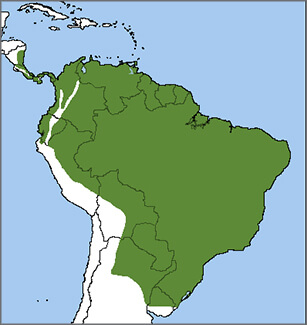 The odd-looking Common Potoo looks similar to the Eastern Whip-poor-will and Chuck-will's Widow and forages at night as they do. It can be located by the reflection of light from its huge yellow eyes and by its haunting song, the subject of much local folklore. In Peru, its song evokes the tale of a lost child calling for his or her mother.
The odd-looking Common Potoo looks similar to the Eastern Whip-poor-will and Chuck-will's Widow and forages at night as they do. It can be located by the reflection of light from its huge yellow eyes and by its haunting song, the subject of much local folklore. In Peru, its song evokes the tale of a lost child calling for his or her mother.
Although considered common, the population of Common Potoo is suspected to be in decline due to ongoing habitat loss.
Sweeping Up Insects
The Common Potoo is widely distributed in southern Central America and throughout the lowlands of northern and central South America. This bird was recently split into two species, with the Mexican and northern Central American form now classified as the Northern Potoo.
Like the nightjars, the Common Potoo has a small, hooked bill with a wide gape, ideal for sweeping up large flying insects such as beetles and moths (although it lacks the rictal bristles around the mouth characteristic of true nightjars). Its upper mandible (beak) does have a tooth-like projection that may serve a similar function as the bird forages.
This nocturnal insectivore starts to hunt just after dusk, making frequent sallies from an exposed perch like some oversized flycatcher. Long wings and tails allow high maneuverability while the bird is in flight.
During the day, the Common Potoo roosts in trees, perching upright on a stump or snag. This bird can remain completely still for long periods and is so beautifully camouflaged by its cryptic plumage that it becomes almost completely invisible.
Keeping an Eye on Threats
The upper eyelids of potoos have several small folds which create slits that serve as “peek-holes” during the day. This adaptation allows the potoo to keep an eye on potential threats while remaining still and keeping its enormous eyes closed.
Sign up for ABC's eNews to learn how you can help protect birds

Common Potoo by Fabio Maffei
The female Common Potoo does not build a nest, instead laying a single egg on top of a stump, broken branch, or in a slight depression on a large tree limb. Both parents take turns incubating the egg. If disturbed, an adult will take its characteristic cryptic posture, with raised head and bill, outstretched neck and compressed plumage. When the threat passes, the bird gradually relaxes to less rigid posture.
Both adults feed the downy white chick by regurgitation. The nestling grows rapidly and soon learns to adopt the same camouflage posture as its parents to avoid threats.
Preserves for Potoos
ABC partners with in-country conservation organizations in 15 countries to protect nearly one million acres of habitat for this and thousands of other species, including critically endangered birds such as the Jocotoco Antpitta, Long-whiskered Owlet, Blue-throated Macaw, and Santa Marta Parakeet.
The Common Potoo can be found at many of the reserves in ABC's Reserve Network, including Tapichalaca in Ecuador, Abra Patricia in Peru, Barba Azul in Bolivia, and El Dorado in Colombia. Birders can find more information on visiting any of these places at conservationbirding.org
Donate to support ABC's conservation mission!



















































